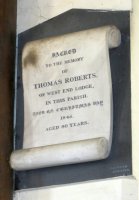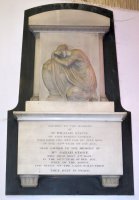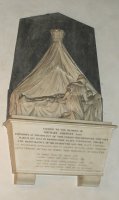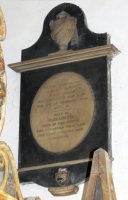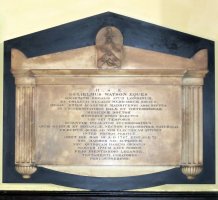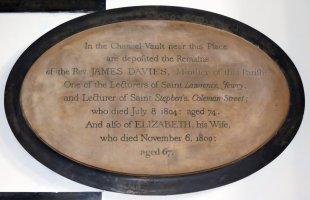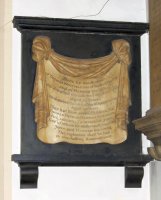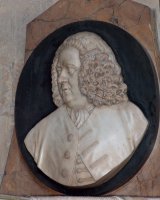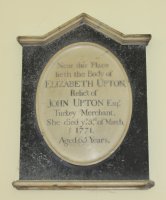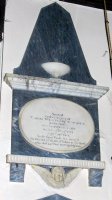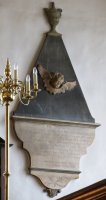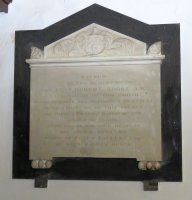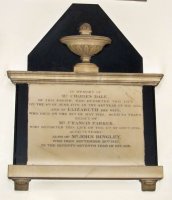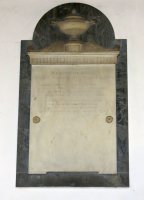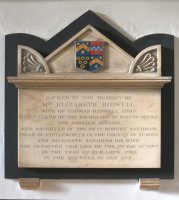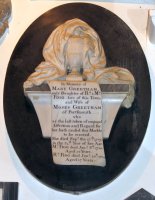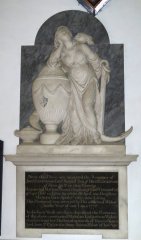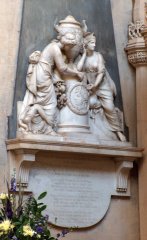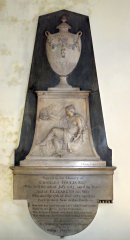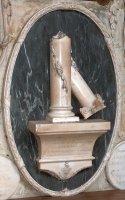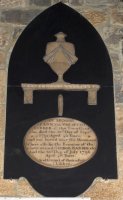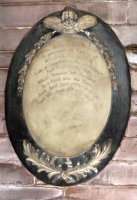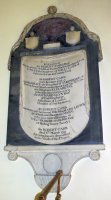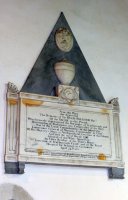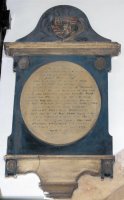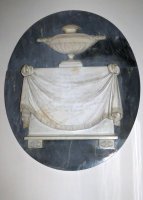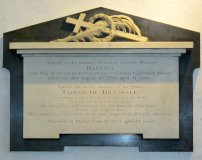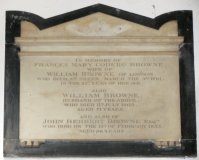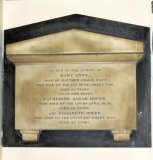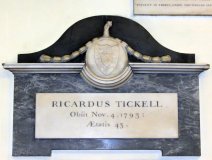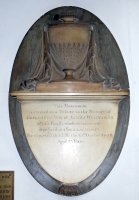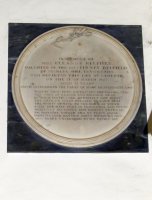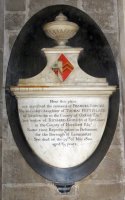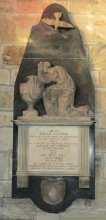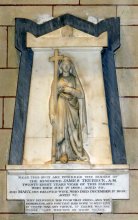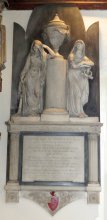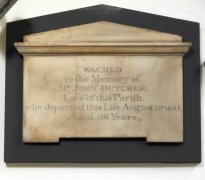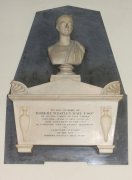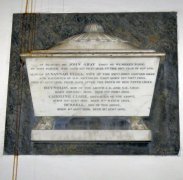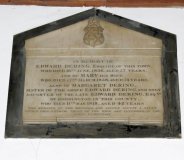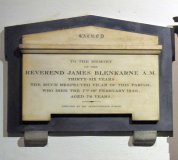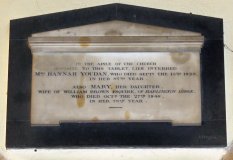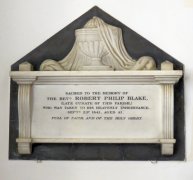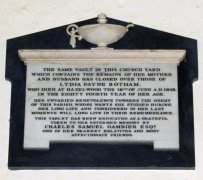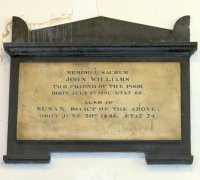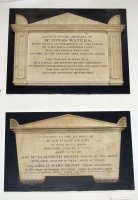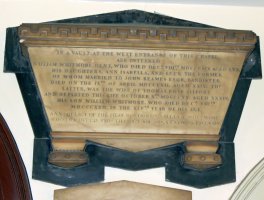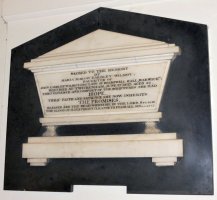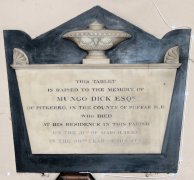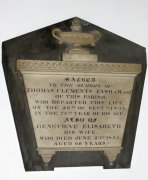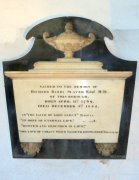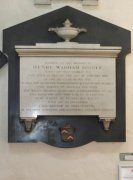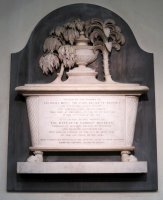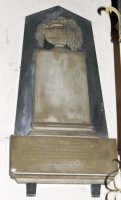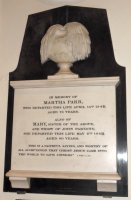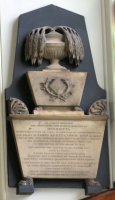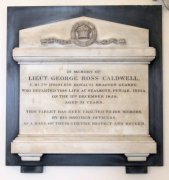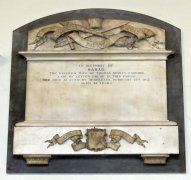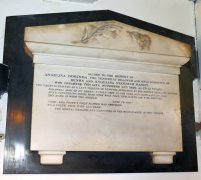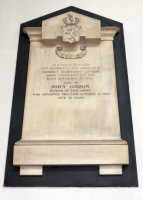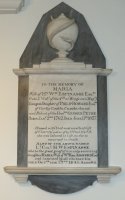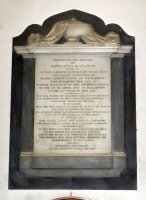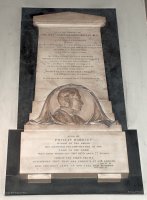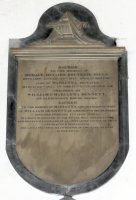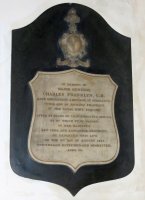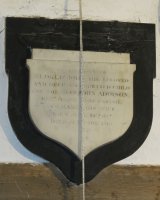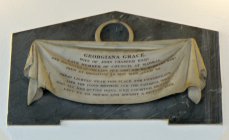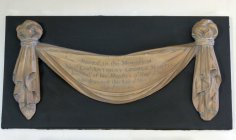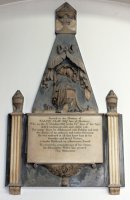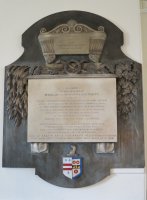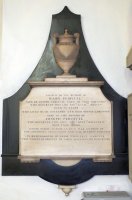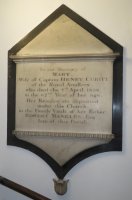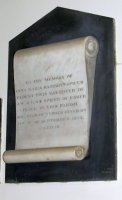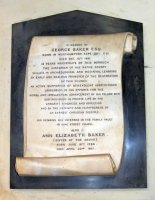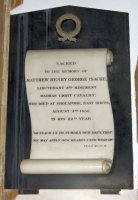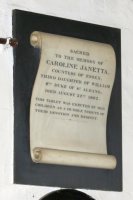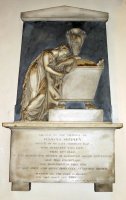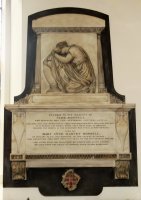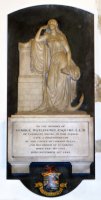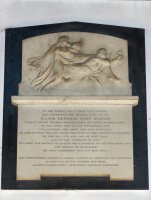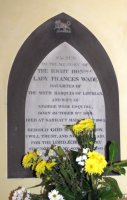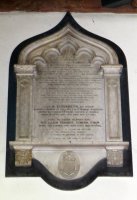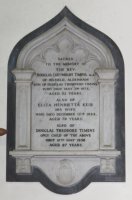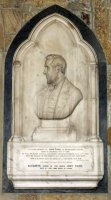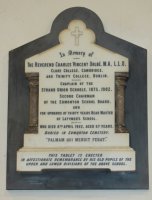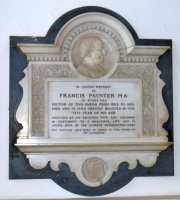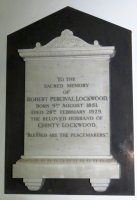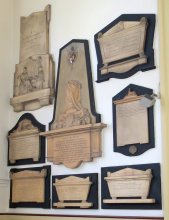White-on-black church monuments
White-on-black monuments are the most frequently found wall monuments in British churches. They were prevalent from the 1790s through to the 1850s, and while some are simple slabs of cut marble, many have at least a little sculptural decoration, and a small proportion have excellent figure sculpture. This page has a look across the range of white-on-black monuments, with around 90 examples of the genre. [As elsewhere on this site, click to enlarge pictures or hover for information.]
If a church has just a couple of monuments, like as not they will be white-on-black, and in most churches with a large collection, the white-on-black panels typically form a large proportion or the majority. The front panel, with the inscription and any sculptural decoration, is in a white marble, occasionally streaked, and often mellowed by time to a cream or beige colour. The backing panel is generally without any carving, a black marble rectangular slab or cut to some other shape. It is not always jet black, but may be a dark grey; lighter greys begin to lose the contrast which is a feature and appeal of these monuments.
Timeline of white-on-black monuments
From early in the history of wall monuments, there had been a few monochrome ones among the more highly coloured alabaster and marble pieces, generally of the 'fireplace' style, bulky classical panels with pillars to the sides supporting a pediment, but typically these were highly streaked marbles as arresting to the eye as their coloured neighbours. The new white-on-black monuments covered here, where the contrast is important rather than the patterns on the marble, first appeared in any numbers early in the 18th Century, becoming fairly widespread by the 1750s. By the 1790s, they were the dominant form, accounting for more than half of all church monuments, and they persisted in the majority through to the 1840s, when numbers of monuments produced for within the church began to fall quite rapidly. They continued to be a significant proportion of the total through till the 1890s, when the move to the colourful Arts and Crafts panels eclipsed them, and then after World War I the relatively low numbers of monuments produced tended to the extreme austerity of a plain stone panel - a handful of white-on-black panels continued to be produced through the 20th Century.
White-on-black monuments went through a gradual period of development and change, with new varieties coming in, through to the 1790s or 1800s. By then, wall panels were reaching maximum production, white-on-black panels were the majority of those, and most of the types had evolved.
Let's go back to the beginning of the white-on-black style, at the dawn of the second part of the 18th Century. Perhaps most of the early examples were obelisk monuments, which were by then an important genre, often highly coloured. These white-on-black ones had the obelisk itself as black, often some white carved pot or figure in front, and then a white panel below - we will see some of these lower down the page. The white might be streaky, the black with some grey inclusions, and it was only gradually that the plainer white-on-black marbles established themselves fully. Here are some of these earlier pieces showing a variety of other designs:
These four are from the 1760s. Above left, we have the white panel as a carved drapery, and shelves on the backing panel. Then a strange almost vertically symmetrical piece with white carved areas at top and bottom. Next, a white portrait on a black roundel, with a coloured panel behind that, and far right, an example of what quickly became a conventional type, with a combination of white and black and minimal carved detail on the white portions - here just the moulding on the shelves and borders, with the main feature being the different juxtaposed dark and light shapes.
1770s white-on-black monuments.
1770s now, and let's see some of the white-on-black obelisk monuments. Above left an example which is streaky white and dark grey rather than pure white-black, but again the idea of the cut-to-shape contrasting backing panel to some carving to the white parts in the foreground, here with a funeral urn or pot carved in high relief in front of the obelisk, and a winged cherub head added to the base. Next another obelisk, with a white cherub head on the obelisk (you'll need to click on the picture to see properly), and a carved pot on top of it. Then a piece with the white part styled as a tomb-chest seen end on, standing on little feet, and with a 'lid' rather like a pediment, with carving upon it and acroteria ('ears') to the sides, seated directly on a shelf. The black backing panel is cut to shape, and has its own little feet. This approach - tomb chest end with lid and acroteria, black backing panel rectangular or mirroring the shape of the white part, became the single most common type of white-on-black panel, as we shall see below. And far right, another, very short obelisk, with a carved pot in front, and to the sides of the inscribed white panel, black strips to form pilasters (flattened pillars).
Developments in the 1780s.
By the 1780s numbers of the white-on-black panels were increasing, and there was something of an experimentation with designs. Above left, a tall panel with carved swan-necked pediment and a pot, and shaped backing, and cut from several pieces of dark and streaky rather than black marble. Then something a bit more like our tomb chest end, here reduced to upper shelf, tall lid enclosing a painted shield of arms, and deeply carved acroteria to the sides. Then a nice white composition of a draped pot seated on some casket with the inscription on a carved scroll, on an oval black background.
Figure sculpture in the white-on-black genre.
And now to the peak of the white-on-black panels, which are the grand figure pieces. These became widespread from the mid-1780s, with works by important sculptors, including John Flaxman and the elder John Bacon. Above left is an example by the eminent Royal Academician Joseph Wilton: the triangular composition of girl leaning against a pot, has the sculpture stretched out past the backing at the base, with a smoking Aladdin's lamp style lamp to the left, and a hook of the anchor (symbol of fortitude, constancy) to the right. Then two pieces by the sculptor John Bacon Sr. Centre above, a complicated piece with two girls, a bullhorn-handled urn on a plinth with a portait of the deceased, and a cornucopia. Then a tall, broad obelisk, with the figure, this time a seated girl carved in lower relief, and carrying a smoky lamp and a plucked flower, on the plinth below the pot.
Here are some non-figural but fairly ambitious carved white-on-black panels, again from the 1780s. Above left, a broken Ionic pillar - symbol of extinction of the male line - on an odd base, with a streaky black oval backing panel within a thin frame carved with corn ears. Centre, another odd one: : the backing cut as a Gothic window shape with lower segment of a circle, and upon that, the curiously disjointed looking pot on a shielf, pin, and oval with inscription. And above right, another oval panel, this time with a winged cherub head and hanging flowers above, and crossed branches below.
1790s variations of the white-on-black style.
1790s now. Above, some interesting variations on the white-on-black style. To the far left, the inscription on a carved, hanging drape, shields above, and a red pot; the backing panel carved with domed dop on which rests a drape tied with a central knot, unusual of its type; the apron below in white again. Next the sharply pointed pyramid to Sir Hugh Palliser, Baronet, d.1796; such pyramids, rather than obelisks, are rather rare. Then, central, another 1796 monument, with the shape of the monument largely defined by the backing panel, and the inscription on a white circle with shelf above, smaller shelf and curvy apron below. Then to the right, oval panel with pot on a tomb chest, finely carved with a knotted drapery. This piece by one of the Westmacott family of sculptors. And far right, a strange panel in the shape of a tall jar, the upper portion including a small carved pot.
White on black tomb chest ends.
Tomb-chest ends were mentioned above, where the inscribed panel has little feet, and a shelf or lid or pediment above, as if it were a sideboard-like tomb chest (also called chest tomb) seen end-on. Here are four examples of these from the 1790s, towards the simpler end of decorative effect. Tomb chest end panels tend to the horizontal format, and as these examples illustrate, the lid or pediment, and the little feet, can form part of the white foreground or the black backing panel, and the backing panel can also follow the outline of the white marble foreground. Such pieces can be made less expensively with no carving at all. Where there is carving, this is commonly on the lid portion.
Oval and circular white-on-black panels.
We've already seen a couple of ovals and circles. These could feature either in the inscribed panel, or the black backing panel, or both. Such cases picked up in the 1800s, from which decade the examples above are taken. Above are two examples with vertical ovals, with the inscription on a white panel curved to fit the space, and the upper portion reserved for a pot. And in the middle, a panel consisting of a circle within a square with a carved floral sprig for decoration - this a minor work by Flaxman incidentally. Further up the page we have a horizontal oval, perhaps rather less usual.
1800s white-on-black figure sculpture.
And three more figure pieces, these from the 1800s. On the left is a figure of a girl kneeling and plunging her face into her sleeve in a mute expression of grief, leaning against a funereal urn. The black backing rises to a curvy obelisk shape above, with a downward plunging bird, reminiscent of the Dove returning to the Ark, and thus Hope, perhaps. There is enough black backing panel lower down to give contrast to the white marble and the surrounding stonework. This is the monument to Maria Lister, by W. and R. Fisher of York, in Bradford Cathedral. In the centre, a smaller, Classically cool figure bearing a tall cross, stands in front of a simple pedimented structure. The backing panel, here streaky grey rather than black, follows the outline of the inner structure. Sir Richard Westmacott RA made this sculpture, to the Revd. James Trebeck, in St Nicholas Church, Chiswick. To the right, a piece by the sculptor Humphrey Hopper, where white predominates, but the oddly-shaped black backing sets off the figures, and the surround to the inscription below highlights the fluted pillars to the sides which might otherwise be lost in the composition.
Some common types
We are now, by the 1800s at the peak of monument production, and the maximum output of white-on-black panels. Let's consider the most common types, which account for many or most of what we can see in the church, aside from the simplest of rectangles.
Tomb chest ends are almost certainly the commonest types of white-on-black panel, with the end-on tomb chest indicated by a block shape cut with shallow feet, a shelf above, and then a low lid or pediment - we saw examples from the 1790s above. Many are simple: cut pieces of marble rather than anything sculptural, with the only carving being the edges of the upper shelf or lip. But there are opportunities for modest sculpture within the pediment or lid, sitting on top of it, as in a pot for example, and at the base.
Tomb-chest ends.
Above are three examples of very simple tomb chest ends. The inscription is on the panel, the carving can be omitted altogether or be of the simplest type, and the blacking backing is generally, but not always, cut to the same outline as the white frontage.
A variant is where the lid is missing, and the black backing is cut to form a pediment shape. The example above left is a nice one with a carved pot on top, by the obscure stonemason Adron, of the New Road, where many statuaries set up shop. Centre, another well-cut piece as a variation on the same theme. That to the right is an example where the whole tomb chest end shape is defined by the black backing panel rather than the white inscribed marble.
Casket end monuments.
An elegant variant on the tomb chest end is the casket tomb: this is of similar shape but with outward slanted sides: the two types are compared above left. The example in the centre has the black backing forming the lid of the casket, and forming a strange outline to the feet below. Often casket ends have their own little shelf on which the feet rest; sometimes, like grand outdoor casket tombs, the feet will be lions' feet, as in the example above right.
1830s-1840s tomb chest ends and caskets.
These two types - tomb chest end and casket - became extremely common by the 1830s, often bearing a pot on top, and with other minor decoration sometimes. We have seen several examples already, and the ones above are cases from the 1830s and 1840s. Above left, is one by the most prolific makers of black-and-white, Gaffin's of Regent Street. Next to it, another casket end, wit carved detailing and the pot particulary well designed. Then a casket tomb with ornate pot on top, feet on carved brackets, and with a curiously shaped black backing. And far right, a more austere tomb chest end of the type with a black pedimental backing, still with a carved pot and brackets, and a carved and painted shield of arms below.
Foliage: dying branches and trees.
Plants often feature in white-on-black monuments of this period. The one above left has two types of tree on either side of a tomb placed on top of the casket; more usually, we have a dying tree or branches, emblematic of the loss of life of the subject, as in the others above. The black backing gives a fine, smooth contrast to the complex form and outline of the foliage (it is worth clicking on the pictures to see this detail). In these examples we see some of the by now familar features - casket tombs with lion's feet, acroteria, the backing either round the whole monument or just in the upper portion, and cut to shape, which may be of a broad obelisk type, incorporate curves, and be sized to act as a narrow pediment-like frame to the white marble foreground. The example second left above moves away from the tomb chest or casket shape to a more vertical format - we will see more of these below.
Decoration within the pediment or lid.
As an alternative to placing a sculptural element on top, it could be within the pediment or lid of the tomb chest or casket. Above left, a straight-forward example, with crown, wreath and motto on a ribbon, nicely proportioned to the space. In the centre, a quite complex design with sculptural decoration within the pediment, and on the base a shield of arms and another undulating ribbon. And to the right a simpler composition, with low relief carving of a flower severed from its stem as a symbol of the loss of a daughter.
So having looked at some variants on tomb chest ends and caskets, let us move on to some alternative shapes.
Vertical format white-on-black monuments.
Vertical format pieces first, another very frequent type, these examples all being from the end of the 1830s. Above left is like a vertically-extended tomb chest end, thus looking more like a plinth, and with an odd protuberance at the top bearing the shield of arms. Next, a panel with extended upper and lower shelves, and a rather good snake wound round a pot on top; the backing panel is dark grey, and cut with a pyramidal shape on top, and to form pilasters to the sides. Then a piece with a pot with a broad drape on top, and layered backing panels, cut at the top in a wavy design. And to the right, a tall plinth with heavy base, and a portrait of the deceased - this by the Birmingham sculptor Peter Hollins.
Shield-shaped white-on-black monuments.
Much less commonly we find white on black panels in shield shapes, which despite the vaguely heraldic appeal, never became popular. Above left, an 1830s example, with the black backing panel closely following the outline of the inscribed white panel, and a wavy upper behind a small carved pot. Centre, a mid-Victorian example with both the backing panel and the inscribed white panel having shield shapes. And above right, one from early in the century, dated 1818.
Horizontal format carved drapery.
Hanging drapes were another variation which persisted; as well as a squarish, tasselled drape style, we also occasionally see horizontal format drapes as above: above left, carved as a taut piece of fabric stretched over a rod - note the decidedly pagan symbol of eternity in the snake swallowing its tail; and above right, a knotted drape, really quite unusual to have the inscription on a piece like this.
Less usual shapes.
Before moving on to later dates, it is worth remarking that there are plenty of white-on-black monuments that do not match any of the above, and have a range of other shapes. Above left, a panel with an obelisk capped by a pot; and with side pilasters incuded in the body of the backing below; a scene with draped funereal urn, dying tree and canopy above is in front of the obelisk. Next, a strangely shaped and composed piece by a significant sculptor, J. G. Bubb. And to the right, a piece with an unusual but strikingly cut curved backing panel. To the far right, a piece with upper triangle and lower curved-side triangle, giving overall a roughly hexagonal monument.
Victorian and later
White-on-black carved scroll monuments.
With the Victorian period, white-on-black monuments styled as unrolling scrolls became more frequent. Carved from a thicker block of marble, they would have been a little more costly. The examples here are typical, with the one to the left an example of an earlier style where a solid back was left to the scroll, which is more usual in outdoor monuments than those in the church. It was fairly typical for the scroll to angle a little to one side to give maximum effect from in front, but there are a goodly number too where this is not the case.
Victorian figure sculpture on white-on-black monuments.
Figure sculpture continued to appear on white-on-black monuments through Victorian times, but now the obelisk is less usual, and the black backing is typically a broader shape. The examples above - you can hover to see who the sculptors were - show a range of compositions of the female figure, and a horizontal composition of three figures to the far right.
Victorian Gothic white-on-black monuments.
And one other Victorian type I have to mention. With the revival of Gothic monuments, the convention was to use stone, usually a beige sandstone, rather than marble, but there are a few examples of white-on-black Gothic panels. These could be as simple as a cut shape consisting of front and backing panel, as above left, but more typically these were Gothic blind windows, of varying degrees of complexity, as in our other examples above. The far right one incorporates a portrait bust.
20th Century white-on-black panels.
By 1900 at the end of the Victorian period, panel monuments in the church were in decline in numbers, and within the reduced numbers, the black-and-white panels had to first compete with beautiful Arts and Crafts monuments with coloured marbles and alabaster, and then later, the post-War tendancy away from ornament to austere plain panels. But a few white-on-black monuments continued to be made. I don't know that I can point to any particular type, except to note a tendancy towards heavily-cut pieces, with abrupt angles and think, chunky marble blocks, exemplified in the three pieces above.
So that is a fair survey I think of the progress of the genre and the more usual types - though it is always nice to find an exception. A second page will cover some of the stonemasons and sculptors who made the white-on-black monuments, in due course.
See also: kneeler monuments // obelisk monuments // Classical girls on monuments // winged cherub heads // skulls
Visits to this page: 2,426 since 2 July 2022
